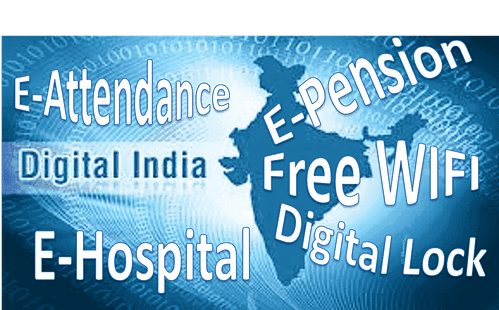
The much published Narendra Modi’s Digital India Initiative has caught the attention of all over the world after his visit to USA, especially when Facebook published his cause in big way. To keep a pace with the changing time Collegesdekho.com brings few interesting facts about digital India especially for the students.
• It was launched on July 1 and the GOI celebrated the first week of July as ‘Digital India Week’. The project was launched at Indira Gandhi Stadium. • Digital India Week witnessed many agreements many sectors like- agriculture Focused Website, project for students like e-schoolbag and many more to improve accessibility and facilitate better knowledge sharing.
• The Digital India initiative has a vision to provide high speed internet services to its citizens in all gram panchayats. Bank accounts will be given priority at individual level. People will be provided with safe and secure cyber space in the country.
• Government services will be available online where citizens will be ensured easy access to it. Transactions will be made easy through electronic medium. •
This is one of the most important factor of the Digital India initiative to provide universal digital literacy and make digital sources easily accessible. The services are also provided in Indian languages for active participation. Major projects under the initiative: • Manufacturing of electronics: The government is focusing on zero imports of electronics. In order to achieve this, the government aims to put up smart energy meters, micro ATMs, mobile, consumer and medical electronics.
• Provide public access to internet: The government aims to provide internet services to 2.5 lakh villages which comprises of one in every panchayat by March 2017 and 1.5 lakh post offices in the next two years. These post offices will become Multi-Service centres for the people.
• Highways to have broadband services: Government aims to lay national optical fibre network in all 2.5 lakh gram panchayats. Broadband for the rural will be laid by December 2016 and broadband for all urban will mandate communication infrastructure in new urban development and buildings. By March 2017, the government aims to provide nationwide information infrastructure.
• Record to Go Online On-line facilities for land records, birth and death certificates may be launched in the same project so that citizens don’t have to run from pillar to post.
• Easy access to mobile connectivity: The government is taking steps to ensure that by 2018 all villages are covered through mobile connectivity. The aim is to increase network penetration and cover gaps in all 44,000 villages.
• e-Governance: The government aims to improve processes and delivery of services through e-Governance with UIDAI, payment gateway, EDI and mobile platforms. School certificates, voter ID cards will be provided online. This aims for a faster examination of data. • IT Training for Jobs: The government aims to train around 1 crore students from small towns and villages for IT sector by 2020. Setting up of BPO sectors in North eastern states is also part of the agenda.
• Bharat Net, a high speed digital highway to connect all 2.5 lakh Gram Panchayats of country. This would be the world's largest rural broadband connectivity project using optical fibre.
• e-Kranti: This service aims to deliver electronic services to people which deals with health, education, farmers, justice, security and financial inclusion.
• Global Information: Hosting data online and engaging social media platforms for governance is the aim of the government. Information is also easily available for the citizens.
• Early harvest programs: Government of India plans to set up Wi-fi facilities in all universities across the country. Email will be made the primary mode of communication. Aadhar Enabled Biometric Attendance System will be deployed in all central government offices where recording of attendance will be made online- Input from DNA
















Similar Articles
List of Aviation Exams in India: Dates, Eligibility, Exam Pattern, Application Form
List of Documents Required for EWS Certificate
List of NAAC 'A+' Grade Colleges 2024-25: State-wise List of Universities and Colleges
MG University UG Admission 2025: Dates, Courses, Eligibility, Application Process, Allotment
Kerala University UG Admission 2025: Application Dates, Eligibility & Admission Process
Kerala NAAC Colleges List 2024-25